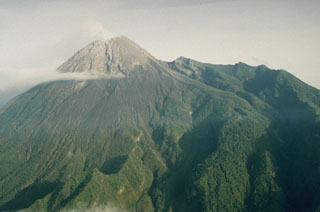Report on Merapi (Indonesia) — 22 September-28 September 2010
Smithsonian Institution / US Geological Survey
Weekly Volcanic Activity Report, 22 September-28 September 2010
Managing Editor: Sally Sennert.
Please cite this report as:
Global Volcanism Program, 2010. Report on Merapi (Indonesia) (Sennert, S, ed.). Weekly Volcanic Activity Report, 22 September-28 September 2010. Smithsonian Institution and US Geological Survey.
Merapi
Indonesia
7.54°S, 110.446°E; summit elev. 2910 m
All times are local (unless otherwise noted)
CVGHM reported that a pattern of increasing seismicity from Merapi began in to emerge in early September. Observers at Babadan (7 km W) and Kaliurang (8 km S) heard an avalanche on 12 September. On 13 September white plumes rose 800 m above the crater. Inflation, detected since March, increased from background levels of 0.1 to 0.3 mm per day to a rate of 11 mm per day on 16 September. On 19 September earthquakes continued to be numerous, and the next day CVGHM raised the Alert Level to 2 (on a scale of 1-4).
Geological Summary. Merapi, one of Indonesia's most active volcanoes, lies in one of the world's most densely populated areas and dominates the landscape immediately north of the major city of Yogyakarta. It is the youngest and southernmost of a volcanic chain extending NNW to Ungaran volcano. Growth of Old Merapi during the Pleistocene ended with major edifice collapse perhaps about 2,000 years ago, leaving a large arcuate scarp cutting the eroded older Batulawang volcano. Subsequent growth of the steep-sided Young Merapi edifice, its upper part unvegetated due to frequent activity, began SW of the earlier collapse scarp. Pyroclastic flows and lahars accompanying growth and collapse of the steep-sided active summit lava dome have devastated cultivated lands on the western-to-southern flanks and caused many fatalities.
Source: Pusat Vulkanologi dan Mitigasi Bencana Geologi (PVMBG, also known as CVGHM)

